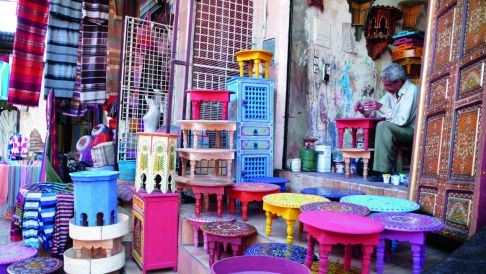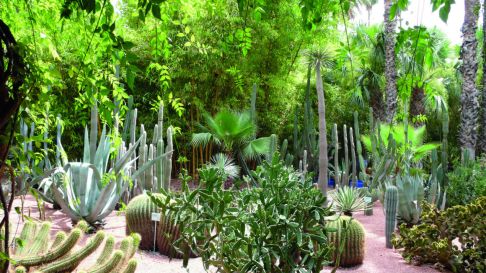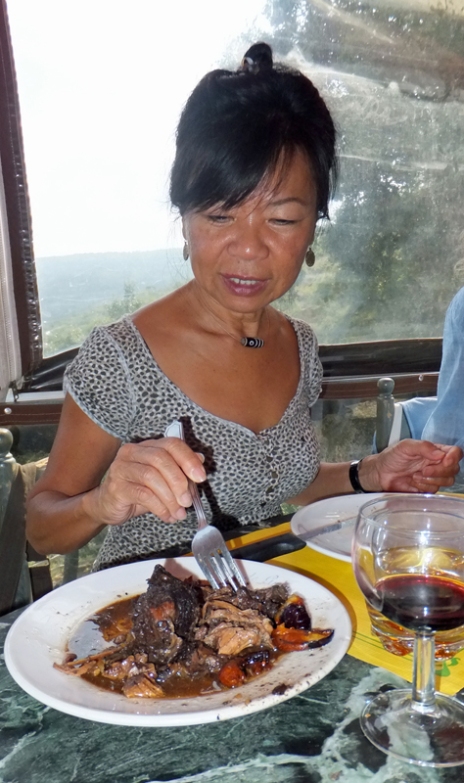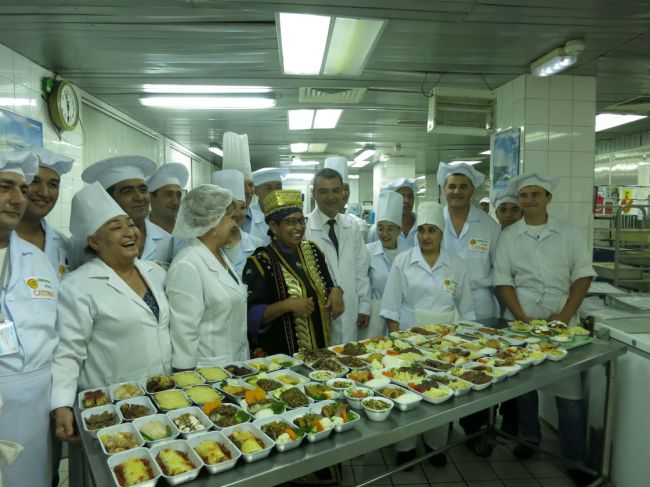In 1969, Crosby, Stills & Nash tickled our imagination with lyrical exotic images of Morocco – of cobras in the square and striped djellebas we can wear – in their song Marrakesh Express. Forty years later, my friend travel writer, Tan Chung Lee adds to the pictures in our head. Photos also by Chung Lee.

The image of a colourful and lively Djemaa el-Fna (pronounced Jamaa’ Elfnaa) sprang to mind the moment I heard the animated drums and singing. It couldn’t be anywhere else.
I had just arrived by train in Marrakesh from Casablanca and had been dropped off by a ‘petit taxi’ at a road curb close to the square to make my way to my riad (traditional Moroccan house converted into a hotel) in the medina. What a welcome after a five-hour flight from Istanbul followed by a three-hour train ride.
Soon after checking in, I hurried out again, to what must be the liveliest square in all of Morocco. There was a heady carnival atmosphere at Djemaa-el-Fna where it seemed as if an entire circus had come to town.
There was a cacophony of music everywhere – from flutes, pipes, tambour, drums and even the bells of water sellers, clad in red costumes and broad-rimmed hats, hawking brass cups of water poured out of a goat-skin bag to passers-by.
The loudest and most stirring music of all came from the Gnaoua spiritual music troops, beating on drums and clicking the kirkbat, which are oversized metal castanets.
Spectators were huddled in groups, entranced by non-stop entertainment provided by snake charmers in one spot, story-tellers in another, dancing ‘lady-boys’ clad in women’s costumes shaking their bon-bons in a far corner and the antics of Barbary apes perched on the shoulders of their roaming owners. Berber women sitting on stools offering henna tattoos dotted the square.
While the entertainers were strutting their stuff, in another part of the square, amid billowing clouds of smoke, was the waft of barbecued food coming from a jumble of stalls, selling an amazing variety of dishes – from snails and soup to deep-fried fish and kebabs.
The irresistible Square
I first had a freshly squeezed orange juice, at one of the many orange and grapefruit stalls that occupy the square all day, unlike the food stalls that only roll in at dusk. Then I tried a small bowl of snails, as an appetizer, for 5 dirhams, before wandering around the square to soak in the ambience.
It was quite intoxicating. What amazed me was how, every time I aimed my camera to snap a photo of some performing group, one of its members would instantly appear to ask for money. I gave a couple of dirhams each time. Later, I was told I was lucky to have escaped with such a small amount. Many tourists have, apparently, been aggressively hassled to give more, sometimes as much as 100 dirhams.

Over the next couple of nights, I would go up to the rooftop terrace of Argana, one of several cafes surrounding the square, for a panoramic ringside view of the action on Djemaa el-Fna and shoot pictures without the subjects of my attention even being aware!
For a true feel of the atmosphere, do eat at least once at one of its food stalls. I tried fish, freshly fried on the spot, choosing to dine at a popular stall with a long queue of people waiting for an empty table or for their takeaway orders. The fish came with a plate of grilled eggplant, mashed to a pulp – a bit like Baba Ganoush – and drizzled with olive oil, and another of mashed tomatoes, both mopped up with bread. The entire tasty meal cost only 24 dirhams (S$4.80).
The action at Djemaa el-Fna does not wind down till well past midnight, when exhausted performers begin to disperse and the food vendors, with steadily diminishing supplies, start to pack up. The quickly emptying square goes into slumber till late afternoon the following day when the clamour returns.
The rest of Marrakesh is just as much of a hubbub; indeed, you will spend hardly a dull moment here. Its old walled city – the medina, with its twisting alleyways – is a delight to explore. This is where you will find colourful souks (markets), selling everything from perfumes and spices to leather bags, shoes and ceramics, and beautiful courtyard homes, many of which have been converted into riads.
Souks and palaces
You might have to dodge donkey carts, bicycles, motorbikes and persistent shopkeepers but a wander through these souks offer a taste of the real Marrakesh, where the sights, sounds and smells of the city come alive.
Tucked amid the souks and houses are some enchanting gems – hammams (old-fashioned Turkish-style baths offering spa and massage treatments; quiet gardens and the organic Earth Café, where you can buy bottles of fabulous olive oil and the prized argan oil processed from the café’s own farms.
Built by the Arabs and dating back to the 9th century, the 16-sq-km medina also contains two palaces, of which the 19th century Bahia Palace is the more spectacular. In contrast, the nearby 16th century El-Badi Palace is bare; only its size alludes to a past grandeur.

Close to the palaces is the former Jewish quarter, the Mellah, where you can wander in the old jewelry souk, now occupied by spice vendors, and admire the tall houses in its winding alleys. Its synagogue with a courtyard marked by the Star of David is still patronized by a small Jewish community.
From YSL chic to the majestic Atlas Mountains
Beyond the medina lies Ville Nouvelle, the modern face of Marrakesh with its stylish shops, restaurants and bars. It was here where I was looking for an epicerie to buy some wines for my trip to the mountains that I stumbled on Majorelle Gardens, a favourite among French tourists, for the magnificent gardens created by French couturier Yves Saint Laurent and his friend, Pierre Berge, who fell in love with the city and are perhaps the first to have kicked off the Marrakesh mania among current travelers.

Marrakesh lies in central Morocco and there is plenty to do within this area. The variety is astonishing too – from the high Atlas mountains, just a 90-minute-drive away, and rock-cut gorges and palm oases, accessible in half a day, to the majestic red sand dunes of the Sahara at Erg Chebbi, reached at the end of a long day.

Keen to do some trekking and inspired by evocative images of Jebel Toubkal, the highest mountain in North Africa, I chose to travel to Imlil, using it as a base for forays into the area. Geographically close to Marrakesh, it is a world apart with snow-capped peaks, lush valleys and hilltop villages.
Apart from the breathtaking scenery, Imlil offers a glimpse of typical village farming life in Morocco, where goats are herded across pastures and fields are tended bywomen, almost all of whom are veiled and in long robes, as this is one of the most conservative parts of the country.
Where are the men? I asked my guide, Mohammed, as we passed a couple of women, who had just collected a huge pile of grass each and were struggling to place it on their backs, to carry home to feed the animals. “I think they need help.” He laughed. “They work with tourists, as guides, only women work in the villages.” He gave each of them a hand and put the load on their shoulders.
Summer in Morocco is hot but in the mountains, it is cool and pleasant. At night, the temperature dips even more and it was a delight to dine on the open-air terrace of my guesthouse, surrounded by views of snow-capped peaks, while the plaintive bleat of goats, herded into the third-storey pens of the local houses, after a day in the pastures, punctured the tranquility.
Ancient Kasbahs and gorgeous gorges
Kasbahs have long been part of the Moroccan landscape. Some Kasbahs were the fortified homes of wealthy families while others were citadels, housing entire village populations. Virtually all of them occupy a strategic position, on hilltops, for defence purposes, and enclosed within high walls.
While many of the Kasbahs have fallen into ruin because of age, some are still in quite pristine condition. On the other side of the Atlas Mountains, on the route known as the Valley of 1000 Kasbahs, I travelled in a shared ‘grand taxi’ along the tortuous but spectacular Tizi n ‘Tichka road to one of Morocco’s most picturesque Kasbahs, the iconic mud-brick Ait Benhaddou.
This fortified city from the 11th century sits on a hill along the Ouarzazate River, on the old caravan route between the Sahara and Marrakesh. Like its high mountains, yawning canyons and red sand dunes, Kasbahs like Ait Benhaddou, which add a splash of colour and charm to an otherwise desolate landscape, conjure up images of romance. Little wonder, it is a favourite among Hollywood producers for use as the backdrop for epic films such as Lawrence of Arabia, Jesus of Nazareth and the most recent, The Gladiator.
Home to an entire village at one time, the Kasbah is now inhabited by less than a dozen families, a few of whom resourcefully allow visitors to tour their three-storey houses and point out props used in various films in return for a small tip.
End your trip in Casablanca (where I started mine). More a city of commerce, Casablanca is less atmospheric than many places in Morocco, but it has a cosmopolitan vibe and many attractive art-deco buildings.
Movie buffs must visit Rick’s Café, opened in 2004, the brainchild of an American diplomat, inspired by the famous Casablanca film. The spirit of the movie is unmistakable in its interior, which faithfully captures the scenes fans will remember, although the movie was shot in Hollywood.
Still, as you nurse a drink while listening to the resident pianist playing As Time Goes By, it is easy to imagine yourself in the Casablanca of the 1940s.
Travel Tips
Getting around
The best way is by sharing a ‘grand taxi’ (usually a Mercedes) with five others. There is no fixed schedule unlike the buses’ you just turn up at the stand for long-distance taxis. You pay for your seat and wait for five other passengers to show up. How long you have to wait depends on the destination and the time of day. Taxis fill up more quickly in the morning and when it is headed to a popular town. To save on waiting time and more comfort, you can pay for more seats or share the cost with other passengers. There were times when I waited only 10 minutes and only once did I have to wait for two hours.
Dining
Morocco’s most famous dish is the tajine, which is actually the name of the inverted funnel-shaped clay vessel used for cooking. There is lamb, chicken, beef, fish and even vegetable tajines to choose from. They are delicious, cooked with a variety of spices and over an open fire for hours. Pair a tajine with a Moroccan wine, which is of good quality.
Speaking of wines, they are only served in licensed restaurants although many unlicensed ones allow you to bring your own wine, without any corkage levied. To buy wines, you should seek out an epicerie (a general grocery store) in Ville Nouvelle.



















